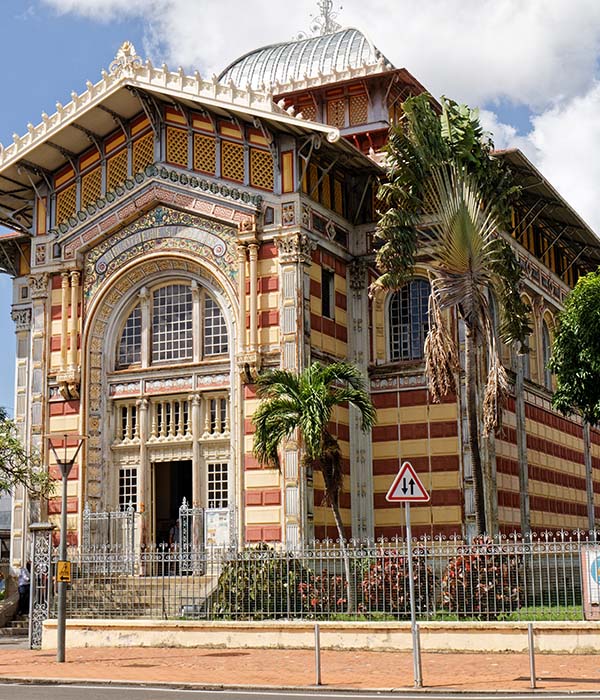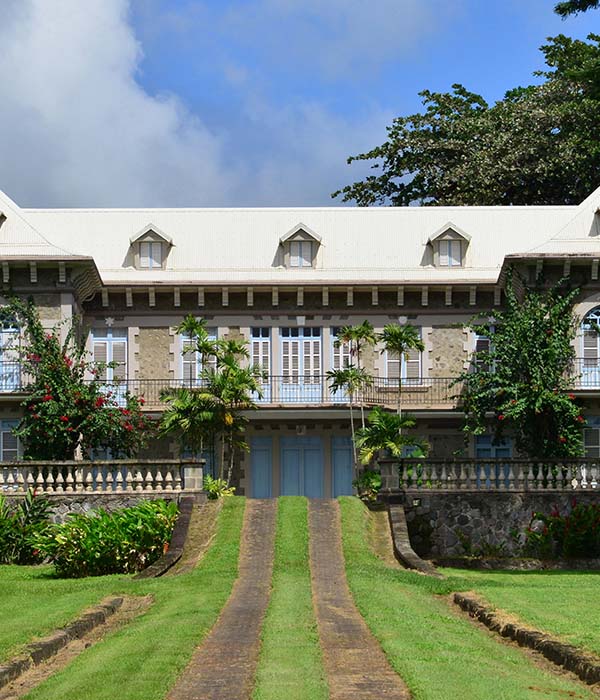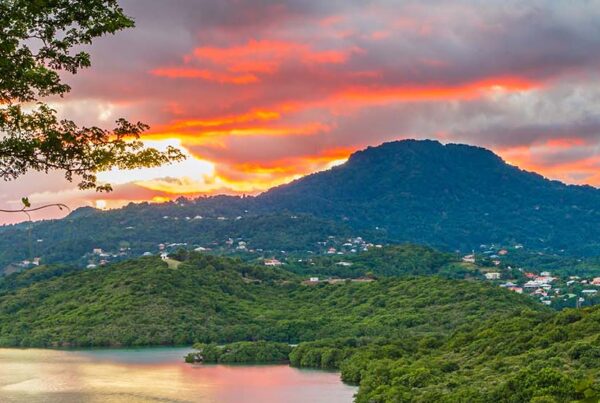Renting a cheap car in Martinique will allow you to explore this island rich in history and culture, where every corner tells a part of its past. With a car, you can easily discover these iconic sites, which are witnesses to the colonial history, Creole culture, and significant events of the island. Here’s a selection of key historical and cultural sites to visit in Martinique, each offering a unique glimpse into the island's past and heritage.
1. Fort Saint-Louis (Fort-de-France)
Located in the heart of the capital, Fort Saint-Louis is an iconic historical monument offering stunning views of Fort-de-France Bay. Built in the 17th century to protect the island from invasions, this fort is still an active military site but partially open for visits. Explore military history while enjoying magnificent panoramas of the Caribbean Sea. The fort is easily accessible by car from downtown Fort-de-France.
2. Bibliothèque Schoelcher (Fort-de-France)
Designated a historical monument, the Bibliothèque Schoelcher is an architectural gem with a unique design. Built in 1887 in Paris and then transported to Martinique, it houses an impressive collection of books and archives. This must-visit location reflects Victor Schoelcher's commitment to the abolition of slavery. Situated in the center of Fort-de-France, near the waterfront, the library is easily reachable by car.


3. Jardin de Balata (Fort-de-France)
Jardin de Balata is a true haven for nature lovers. This botanical garden is located just a few kilometers from Fort-de-France and features a stunning collection of tropical plants, exotic flowers, and majestic trees. Strolling along the suspended walkways among the trees allows you to discover the island's biodiversity from a unique perspective. The garden is easily accessible by car, providing a refreshing break during your exploration.
4. Habitation Clément (Le François)
This former sugar cane plantation is now a major cultural site in Martinique. In addition to a rum distillery, Habitation Clément boasts a beautifully restored colonial house surrounded by extensive botanical gardens. Here, you can explore the history of rum in Martinique and discover Creole architecture. Located in Le François, Habitation Clément is accessible by car and offers an immersive experience into the island's history and culture.
5. Musée de la Pagerie (Trois-Îlets)
This museum is housed in the former birthplace of Joséphine de Beauharnais, who later became Empress of France by marrying Napoleon Bonaparte. The museum chronicles Joséphine's life and the history of the sugar plantation where she was born. Located in Trois-Îlets, this site is easily accessible by car and is a must-visit for those interested in the history of Martinique and France.
6. Mémorial de l'Anse Cafard (Le Diamant)
This poignant monument stands facing the Atlantic Ocean, commemorating the memory of the slaves who perished in the shipwreck of a slave ship in 1830. The statues, turned towards the sea, symbolize the suffering and resilience of enslaved people. This memorial serves as a place of reflection and remembrance, located just a few kilometers from the village of Le Diamant and easily accessible by car.


7. Depaz Distillery (Saint-Pierre)
Located at the foot of Montagne Pelée, this historic distillery offers an exceptional setting to discover the production of agricultural rum, a symbol of Martinique. You can tour the distillery, taste various rums, and explore the estate's gardens. The history of the distillery is closely linked to that of Saint-Pierre, the former capital of the island, which was destroyed by a volcanic eruption in 1902. The Depaz Distillery is accessible by car, and a visit to Saint-Pierre perfectly complements the experience.
8. JM Distillery (Macouba)
Nestled in the mountains of the northern part of the island, JM Distillery is one of the most authentic distilleries in Martinique. By visiting this distillery located in Macouba, you'll learn about the process of making agricultural rum amidst a sugarcane plantation. The site, surrounded by lush greenery and with views of Montagne Pelée, offers a unique experience that combines nature and tradition. Easily accessible by car, JM Distillery is a must-visit for rum enthusiasts.
9. The Sugar Cane Museum (Trois-Îlets)
This museum, located in a former distillery, traces the history of sugar cane in Martinique, from its introduction by colonizers to its current economic and social role. You will discover the evolution of cultivation and processing techniques, as well as the history of the workers who contributed to its development. The museum is situated in the commune of Trois-Îlets and is easily accessible by car.
10. Martinique Zoo and Habitation Latouche (Le Carbet)
The Martinique Zoo is set on the ruins of Habitation Latouche, one of the oldest plantations on the island. In addition to discovering local and exotic wildlife, you can explore the historical remnants of the plantation and its gardens. It's a perfect outing to combine nature exploration with an immersion in Martinique's colonial history. The site is accessible by car from the town of Le Carbet.
11. Earth Sciences Discovery Center (Saint-Pierre)
Located in the former capital of Martinique, this center immerses you in the geological history of the island, particularly that of Montagne Pelée, whose eruption in 1902 marked the history of Saint-Pierre. You can learn more about volcanoes and earthquakes while exploring this educational and interactive site. The center is easily accessible by car, and the visit can be combined with discovering Saint-Pierre and its historic ruins.










